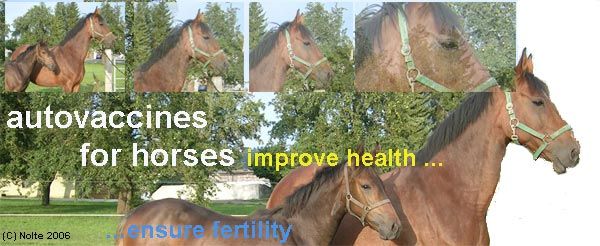

Autogenous vaccines (horses/mares/foals)This site provides information to inform veterinarians, breeder, and animal keepers about autogenous vaccines (autovaccines, herd specific vaccines, autologous biologicals) for the treatment of infectious diseases in horses (bronchopneumonia, metritis, others). [Introduction] [Infections] [Autovaccines] [products] [references] [credits] [(c)] Introduction about autogenous vaccines/autovaccinesTreatment of infectious diseases by use of autogenous vaccines has a long tradition in veterinary medicine. Unlike antibiotics, which target the micro-organism directly, autogenous vaccines pursue the strategy to gently help the immune system of an infected animal to cope with an infectious disease causing micro-organism. Consequently, autovaccination is a method to specifically modulate the immune system of the infected animal by offering a tailored antigen (i.e. the autogenous vaccine). Autogenous vaccines may be used for prophylaxis (i.e. like bacterins) or for the treatment of infections already present and manifest diseases. Obligate requirement is that the disease causing micro-organism (i.e. the etiologic agent) is available (within any specimen, e.g. swab, tissue, faeces, etc.). Application form may vary, per oral, intra nasal, intra vaginal and subcutaneous applications are possible, depending on the type of disease to be prevented/treated. Infectious diseases in horsesHorses maybe subject to a large variety of different pathogenic micro-organism. While in a number of cases treatment with an antimicrobial drug might provide relief for the infected animal, antimicrobial therapy may fail in other cases. Treatment failure and repeated therapy is a source of potential harm for the animal, making it weak and triggering development of both, antimicrobial resistance and chronic, incriminating disease. Infections of the reproductive tract most likely causes temporal infertility, making expensive treatments necessary. Autogenous vaccines/autovaccines as alternativesIn a recent article by Nolte et al (2004), printed in a German veterinary journal, we have provided data regarding the effectiveness of autogenous vaccines in the treatment of disease of the respiratory tract in horses {include reference}. Our data show, that while attempts to control infection by use of antibiotics may not be successful, autogenous immune stimulation by autovaccination is a highly promising alternative. Similar results have been observed in the treatment of metritis (paper in preparation). Please visit www.autovaccine.de |
|
|
List of available autovaccines, autogenous vaccines, and autogenous biologicals * |
|||
|
|
autogenous vaccine against |
species |
indication and application route |
|
1. |
E. coli diarrhea |
horse |
therap.-peroral |
|
1a. |
- ß-hemolysing |
||
|
|
- mucoid |
||
|
|
- R-forms |
||
|
1b. |
in combination with Proteus ssp. Bacillus cereus, Pseudomonas ssp. |
|
|
|
2. |
Infections with Pasteurella sp. |
horse |
therap. & prophyl. sc / or i.n. |
|
3. |
Infections with Chlamydia psittaci or Chlamydophila ssp. (see: DPat.-Nr. DE198 604 38; EP 1140160 B1 |
horses |
therap. & prophyl.-sc |
|
4. |
Infections with Pseudomonas sp. Pseudomonadaceae (Non-fermenting Gram negative rods/Stenotrophomonas and others.) |
|
|
|
4a. |
Bronchopneumonia |
horse |
therap.-sc |
|
4b. |
Throat-/nose-/ear infections and ceratoconjunctivitis |
horse |
therap.- peroral + sc |
|
5. |
pyodermia caused by Staphylococcus aureus, S. intermedius, S. hyicus etc |
horse |
therap.-sc |
|
6. |
Papillomatosis (Warts) and Equine Sarcoid (see: D-Pat.Application.: 100 21 433; Int.Pat.Application.:WO 0024420) |
horse, donkey, zebra |
therap.-sc |
|
7. |
Chlamydia/Actinomyces (Arcanobacterium) pyogenes (see patents under 3. as well as Nolte et al 2001) |
horse |
proph.-sc |
|
8a. |
Rhodococcus equi (Corynebacterium equi) |
in foal |
sc for prophylaxis in foals |
|
8b. |
|
mares and horses, donkey, zebra |
therap. u. prophyl. sc |
|
9. |
Streptococcus equi, zooepidemicus, equisimilis |
horse, donkey, zebra |
prophyl.-sc/ therap.-sc |
|
10. |
Bacillus cereus |
horse, donkey, zebra |
therap.-sc |
|
11. |
Bacillus cereus/E.coli |
horse, donkey, zebra |
therap.-peroral |
|
12. |
Corynebacterium sp. [Actinomyces(Arcanobacterium)] metritis |
in foal mares |
therap./prophyl. sc |
|
13. |
Klebsiella sp. |
horse |
therap.-sc/peroral |
|
14. |
Microsporum ssp., Trichophyton ssp. (Dermatomycosis) |
horse, donkey, zebra |
therap.-sc/peroral |
|
15. |
Yeast (e.g. Candida ssp.) (Metritis) |
mares |
therap./prophyl.sc |
References:Patents:WEISS, H.-E, WEISS, H., NOLTE, O. & SONNTAG, H.-G. (1998): Publications:NOLTE, O., MORSCHER, J., WEISS, H.-E. & SONNTAG, H.-G. (2001): CreditsResponsible for the content: Hans-Erich Weiss (DVM) [Contact-Information] The image shown at the beginning of this page was kindly provided by Dr. T. Pfefferle (Mengen, Germany) and was modified to fit the requirements of this website. The picture shows a mare with its foal. Successful insemination of the mare was possible when a yeast infection was positively influenced by homologous autovaccination. The pdf files are offered for download with permission of Terra Verlag (Tierärztliche Umschau). CopyrightsThe complete page and any content therein (text, pictures, etc.) are protected by copyrights even if this is not explicitly mentioned in/on a particular part of this site. (C) Priv.Doz. Dr. O. Nolte 2006/2007 Inquiries and comments about autovaccines please send to H.-E. Weiss (weiss-at-autovaccine.de // Hans-Erich.Weiss-at-cvuaka.bwl.de) [Introduction] [Infections] [Autovaccines] [products] [references] [credits] [(c)] |
[back to top]
keywords: veterinary medicine, horses, foals, mares, metritis, fertility, autovaccines, autogenous vaccines, autogenous biologicals, reduced consumption of antibiotics
launched: March 14th 2006 // last edited: December 16th 2007